MARIANI’S
Virtual
Gourmet
December
20, 2020
NEWSLETTER
Founded in 1996
ARCHIVE
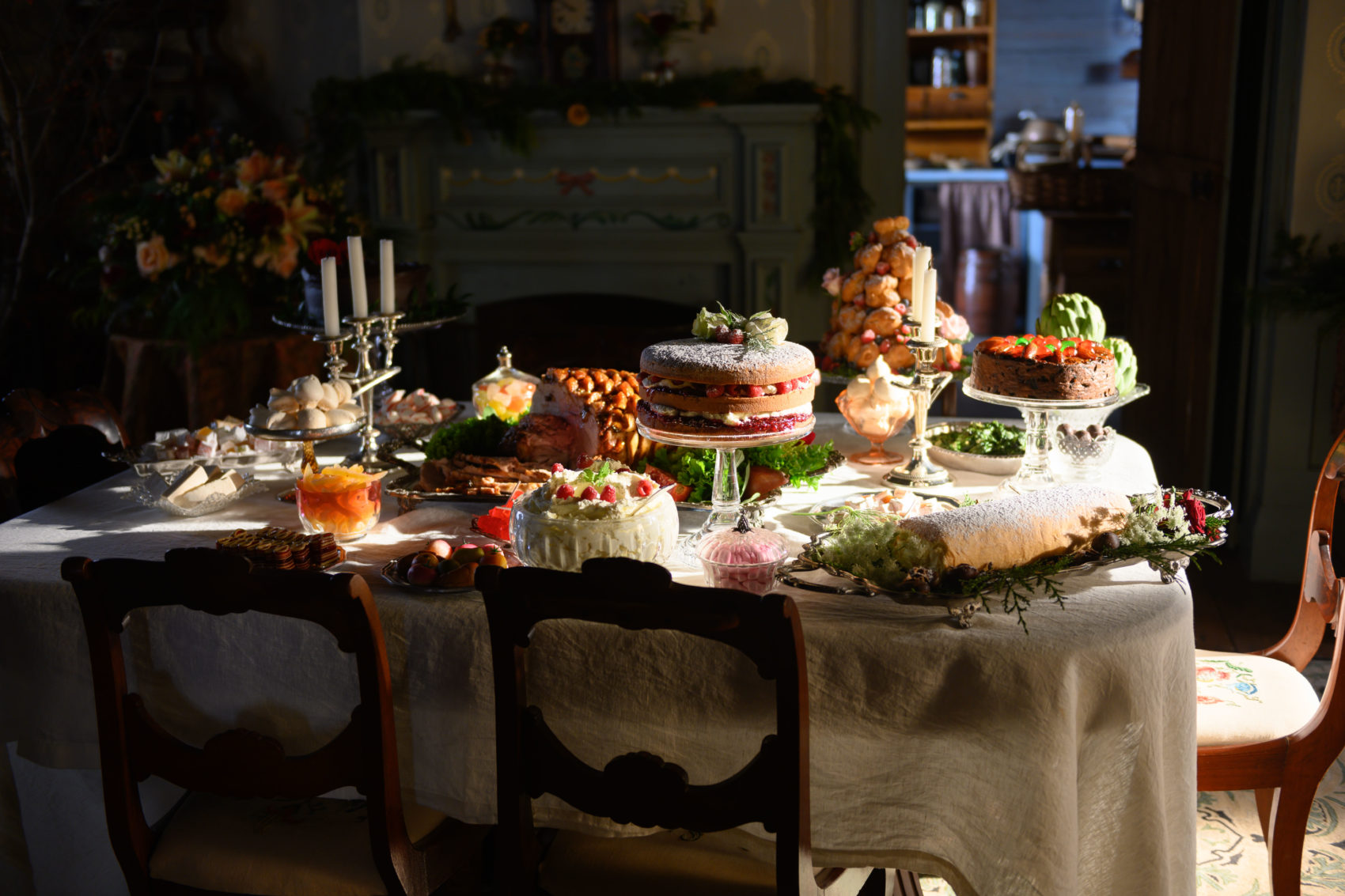
CHRISTMAS DINNER IN THE MOVIE "LITTLE WOMEN" (2019)
IN THIS ISSUE
A CHILD'S CHRISTMAS IN THE BRONX
By John Mariani
NEW YORK CORNER
LOVE AND PIZZA
CHAPTER 39
By John Mariani
NOTES FROM THE WINE CELLAR
LIFTING HOLIDAY SPIRITS
By John Mariani
❖❖❖
A CHILD'S CHRISTMAS IN THE BRONX
By John Mariani

Maybe it didn't snow
for Christmas every year in the Bronx back in the
'50s. But my memory of at least one perfect
snow-bound Christmas Eve makes me think it did
often enough that I still picture my neighborhood
as white as Finland in those days when I lived
along the choppy waters of the Long Island Sound.
 But
for all the decorations and the visits to stores,
the Bronx Zoo and Rockefeller Center, it was the
sumptuous Christmas feasts that helped maintain our
families' links to the Old Country long after most
other immigrant traditions had faded away. Food was
always central to everyone's thoughts at Christmas,
and the best cooks in each family were renowned for
specific dishes no one else dared make.
But
for all the decorations and the visits to stores,
the Bronx Zoo and Rockefeller Center, it was the
sumptuous Christmas feasts that helped maintain our
families' links to the Old Country long after most
other immigrant traditions had faded away. Food was
always central to everyone's thoughts at Christmas,
and the best cooks in each family were renowned for
specific dishes no one else dared make.
The assumption that everything would be exactly the
same as last year was as  comforting as knowing that
Christmas Day would follow Christmas Eve. The finest
ancestral linens were ironed and smoothed into
place, dishes of hard candy were set out on every
table, and the kitchen ovens hissed and warmed our
homes for days. The reappearance of the old
dishes, the irresistible aromas, tastes and
textures, even the seating of family members in the
same spot at the table year after year anchored us
to a time and a place that was already changing more
rapidly than we could understand.
comforting as knowing that
Christmas Day would follow Christmas Eve. The finest
ancestral linens were ironed and smoothed into
place, dishes of hard candy were set out on every
table, and the kitchen ovens hissed and warmed our
homes for days. The reappearance of the old
dishes, the irresistible aromas, tastes and
textures, even the seating of family members in the
same spot at the table year after year anchored us
to a time and a place that was already changing more
rapidly than we could understand.
 It's funny now to
think that my memories of the food and the dinners
are so much more intense than those of toys and
games I received, but that seems true of most
people. The exact taste of Christmas cookies, the
sound of beef roasting in its pan, and the smell of
evergreen mixed with the scent of cinnamon and
cloves and lemon in hot cider were like holy incense
in church, unforgettable, like the way you remember
your parents' faces when they were young.
It's funny now to
think that my memories of the food and the dinners
are so much more intense than those of toys and
games I received, but that seems true of most
people. The exact taste of Christmas cookies, the
sound of beef roasting in its pan, and the smell of
evergreen mixed with the scent of cinnamon and
cloves and lemon in hot cider were like holy incense
in church, unforgettable, like the way you remember
your parents' faces when they were young.
No one in our neighborhood was poor but few were
rich. Yet we mounted  feasts as lavish as any I could
imagine in a book, and in the days preceding
Christmas people took enormous joy in spending their
money on foods only eaten during that season.
feasts as lavish as any I could
imagine in a book, and in the days preceding
Christmas people took enormous joy in spending their
money on foods only eaten during that season.
It was still a time when the vegetable man would
sell his produce from an old truck on Campbell
Drive, and Dugan's and Krug's bread men came right
to your door with special holiday cupcakes and
cookies. We'd go to Biancardi's Meats on
Arthur Avenue and, while the butcher on Middletown
Road usually carried fresh fish only on Fridays, he
was always well stocked with cod, salmon, lobsters
and eel during the holidays. The pastry shops
worked overtime to bake special Christmas breads and
cakes, which would be gently wrapped in a swaddling
of very soft pink tissue paper tied up with ribbons
and sometimes even sealed with wax to deter anyone
from opening it before Christmas.
By Christmas Eve the stores ran out of everything,
and pity the poor cook who delayed buying her
chestnuts, ricotta cheese, or fresh yeast until it
was too late. Weeks in advance the women would put
in their order at the live poultry market for a
female rabbit—not a male—or a goose that had to
weigh exactly twelve pounds.
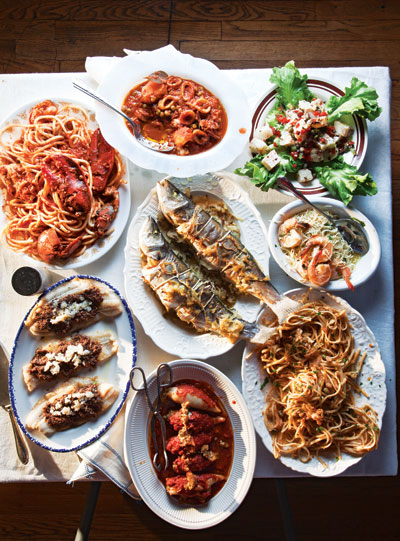 You always knew
what people were cooking for Christmas because the
aromas hung in the hallways of the garden apartments
and the foyers of their homes— garlicky tomato
sauces, roast turkeys, rich shellfish stews, and the
sweet, warm smells of pastries and breads could make
you dizzy with hunger. When you went out into
the cold, those aromas would slip out the door and
mingle with the biting sea-salted air and the fresh
wet snow swept in off the Sound.
You always knew
what people were cooking for Christmas because the
aromas hung in the hallways of the garden apartments
and the foyers of their homes— garlicky tomato
sauces, roast turkeys, rich shellfish stews, and the
sweet, warm smells of pastries and breads could make
you dizzy with hunger. When you went out into
the cold, those aromas would slip out the door and
mingle with the biting sea-salted air and the fresh
wet snow swept in off the Sound.
At the Italian homes in the
Bronx ancient culinary rituals were followed long
after they'd lost their original religious
symbolism. The traditional meatless meal of
Christmas Eve—“La Vigilia”(left)—which began
centuries ago as a form of penitential purification,
developed into a robust meal of exotic seafood
dishes that left one reeling from the table.
According to the traditions of Abruzzi,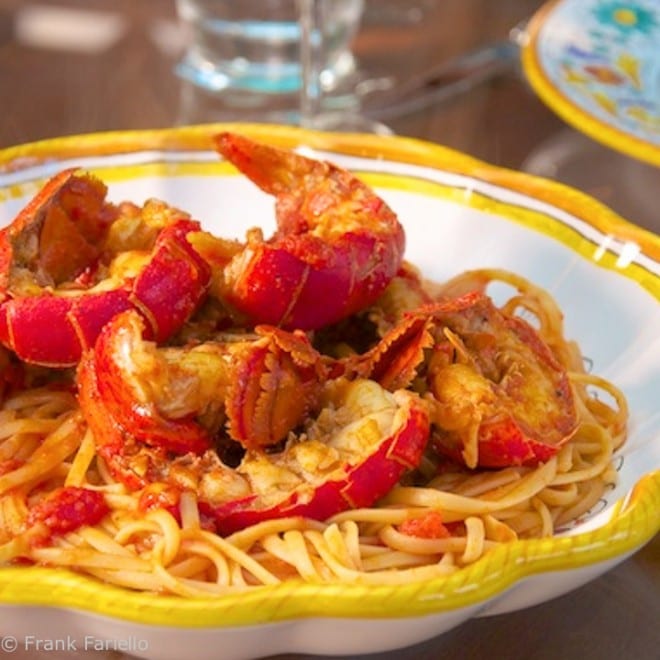 where my father's family came from, the Christmas
Eve dinner should be composed of seven or nine
dishes—mystical numbers commemorating the seven
sacraments and the Holy Trinity multiplied by
three.
where my father's family came from, the Christmas
Eve dinner should be composed of seven or nine
dishes—mystical numbers commemorating the seven
sacraments and the Holy Trinity multiplied by
three.
This was always my Auntie Rose's shining
moment. She would cook with the zeal and energy of a
dozen nuns, beginning with little morsels of crisply
fried calamari. She made spaghetti on a
stringed utensil called a "ghitarra" and served it
with a sauce teeming with shellfish. Next came
an enormous pot of lobster fra diavolo (right)—a
powerful coalescence of tomato, garlic, onion,
saffron and hot red peppers, all spooned into soup
plates around shiny, scarlet-red lobsters that some
guests attacked with daunting, unbridled gusto while
others took their dainty time extracting every
morsel of meat from the deepest recesses of the
body, claws and legs.
Few children would eat
baccala, a strong-smelling salted cod cooked for
hours in order to restore its leathery flesh to
edibility, and stewed eel, an age-old symbol of
renewal, was a delicacy favored mostly by the
old-timers. But everyone waited for the dessert—the
yeasty, egg bread called "panettone,"
shaped like a church dome and riddled with golden
raisins and candied fruit.
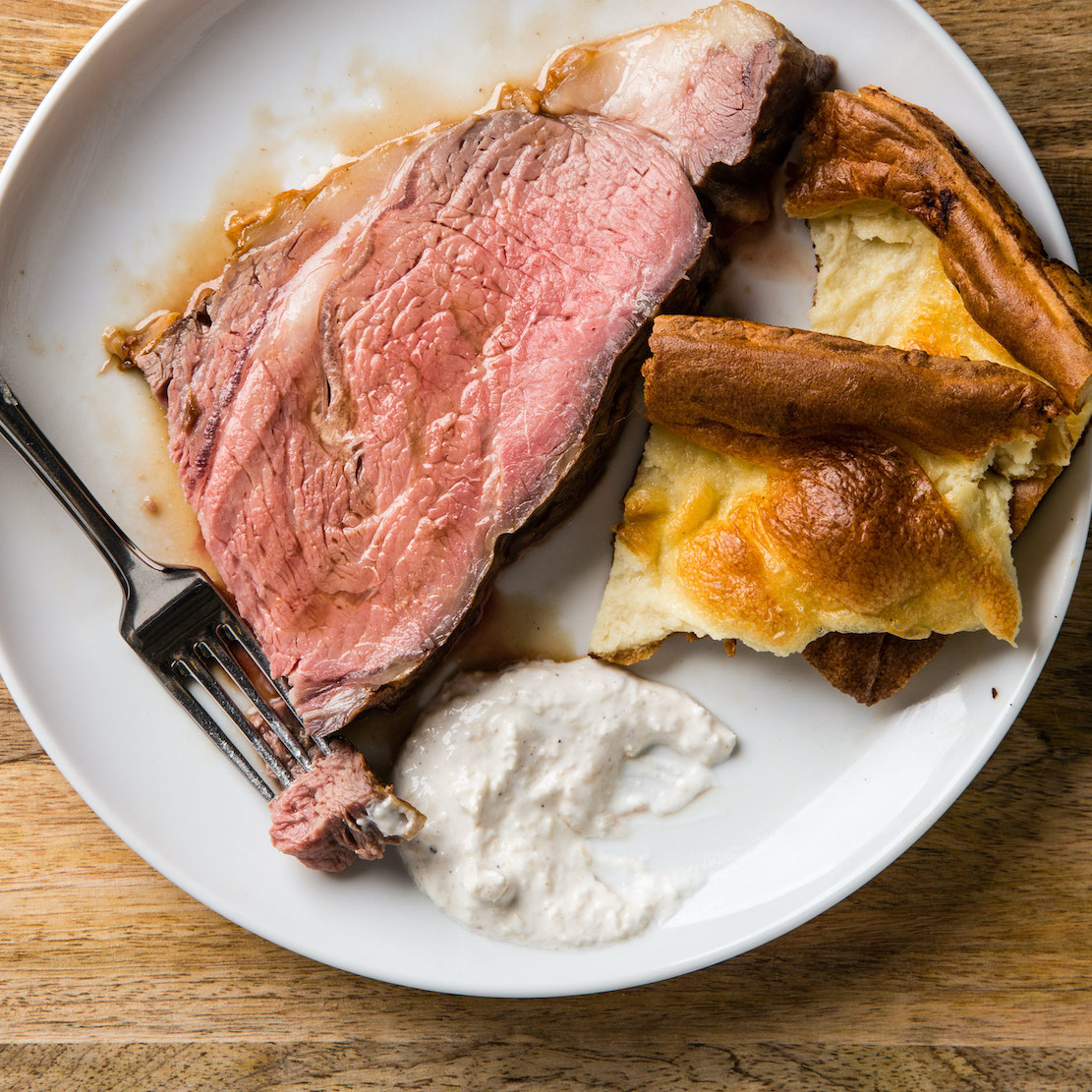 Christmas Day
came too early for everyone but the children, but as
soon as presents were exchanged, my mother and
grandmother would begin work on the lavish Christmas
dinner to be served that afternoon. It was always a
mix of regional Italian dishes and American
novelties, like the incredibly rich, bourbon-laced
egg nog my father insisted on serving before my
grandmother's lasagna, in which were hidden dozens
of meatballs the size of hazelnuts. Then my mother
would set down a massive
Christmas Day
came too early for everyone but the children, but as
soon as presents were exchanged, my mother and
grandmother would begin work on the lavish Christmas
dinner to be served that afternoon. It was always a
mix of regional Italian dishes and American
novelties, like the incredibly rich, bourbon-laced
egg nog my father insisted on serving before my
grandmother's lasagna, in which were hidden dozens
of meatballs the size of hazelnuts. Then my mother
would set down a massive  roast beef,
brown and crackling on the outside, red as a
poinsettia within, surrounded by sizzling roast
potatoes and Yorkshire pudding glistening from the
fat absorbed from the beef. Dessert reverted
to venerable Italian tradition with my grandmother's
prune-and-chocolate-filled pastries and honeyed
cookies called "struffoli" (right).
And someone always brought panforte,
an intensely rich, thick Sienese fruit and nut cake
no one could eat more than a sliver of.
roast beef,
brown and crackling on the outside, red as a
poinsettia within, surrounded by sizzling roast
potatoes and Yorkshire pudding glistening from the
fat absorbed from the beef. Dessert reverted
to venerable Italian tradition with my grandmother's
prune-and-chocolate-filled pastries and honeyed
cookies called "struffoli" (right).
And someone always brought panforte,
an intensely rich, thick Sienese fruit and nut cake
no one could eat more than a sliver of.
After such a meal, we needed to go for a walk in the
cold air. In other homes up and down our block
people were feasting on Norwegian lutefisk, Swedish
meatballs, German stollen, Irish plum pudding and
American gingerbread. If you stopped and listened
for a moment, you could hear the families singing
carols in their native tongue.
 By early evening
guests got ready to leave and leftovers were packed
up to take home, belying everyone's protest that
they wouldn't eat for days afterwards.
By early evening
guests got ready to leave and leftovers were packed
up to take home, belying everyone's protest that
they wouldn't eat for days afterwards.
By then the snow had taken on
an icy veneer and the wind died down to a
whisper. I remember how the cold air magnified
sounds far, far away, so as I crept into bed I could
hear the waves lapping the sea wall and the rattling
clack-clack, clack-clack of the El running from
Buhre Avenue to Middletown Road. It was a kind of
lullaby in those days, when it never failed to snow
on Christmas in the Bronx.
❖❖❖
By John Mariani
LOVE AND PIZZA
Since, for the time being, I am unable to write about or review New York City restaurants, I have decided instead to print a serialized version of my (unpublished) novel Love and Pizza, which takes place in New York and Italy and involves a young, beautiful Bronx woman named Nicola Santini from an Italian family impassioned about food. As the story goes on, Nicola, who is a student at Columbia University, struggles to maintain her roots while seeing a future that could lead her far from them—a future that involves a career and a love affair that would change her life forever. So, while New York’s restaurants remain closed, I will run a chapter of the Love and Pizza each week until the crisis is over. Afterwards I shall be offering the entire book digitally. I hope you like the idea and even more that you will love Nicola, her family and her friends. I’d love to know what you think. Contact me at loveandpizza123@gmail.com
—John Mariani
To read previous chapters go to archive (beginning with March 29, 2020, issue.
LOVE AND PIZZA
Cover Art By Galina Dargery
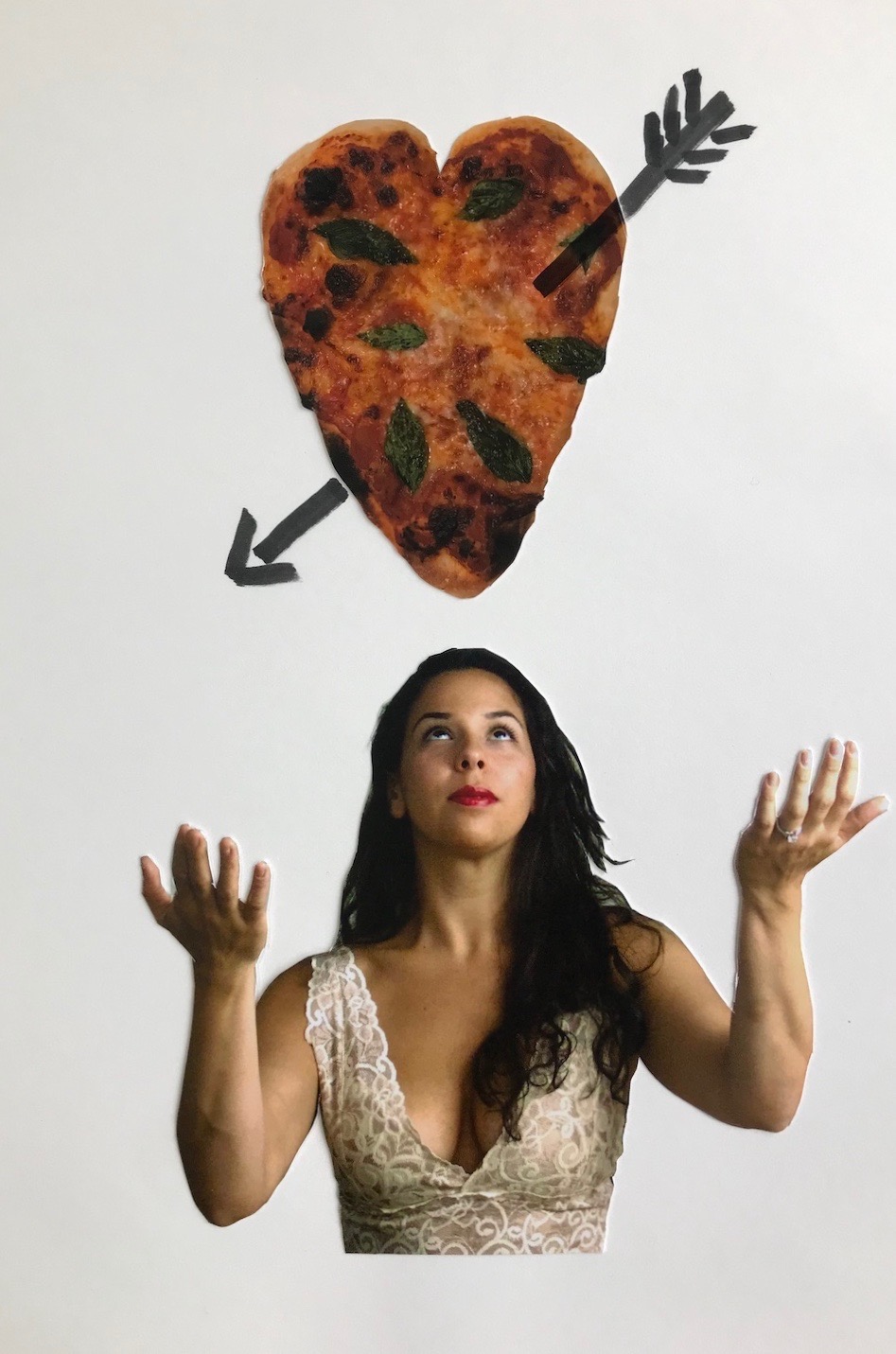
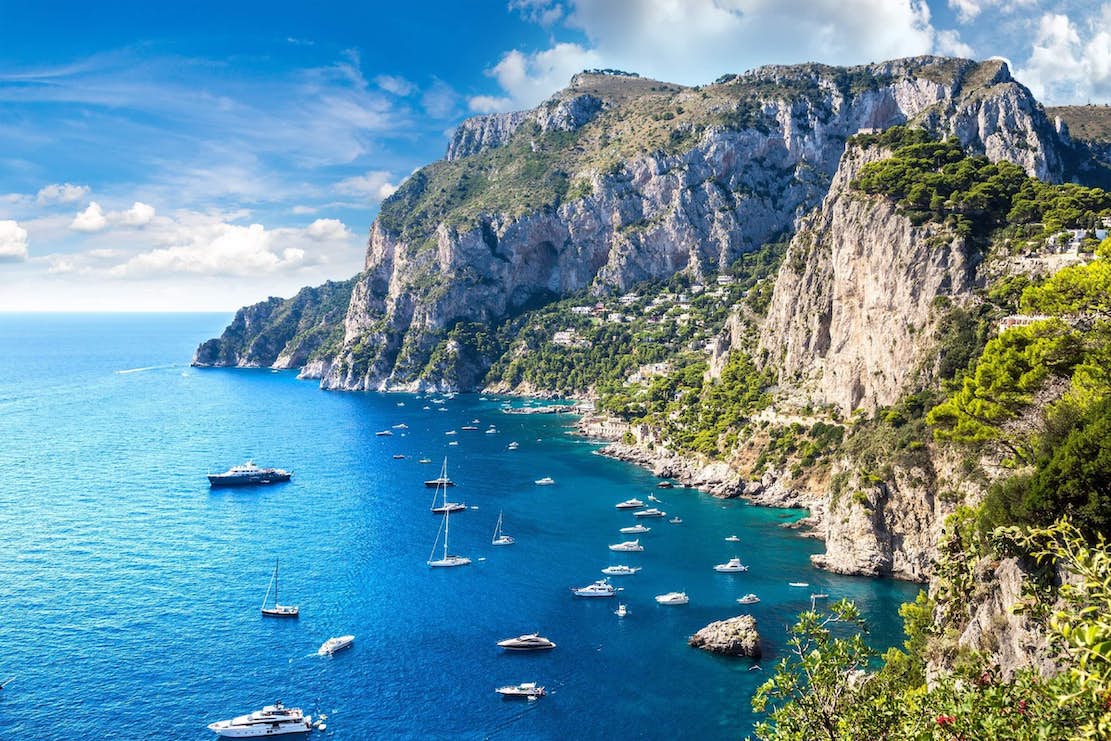
CAPRI
The
show the next morning went splendidly and the
audience, though not as large as that in
Milan, applauded the clothes with obvious
enthusiasm.
This time Nicola was accorded no more
nor less the applause of the other girls.
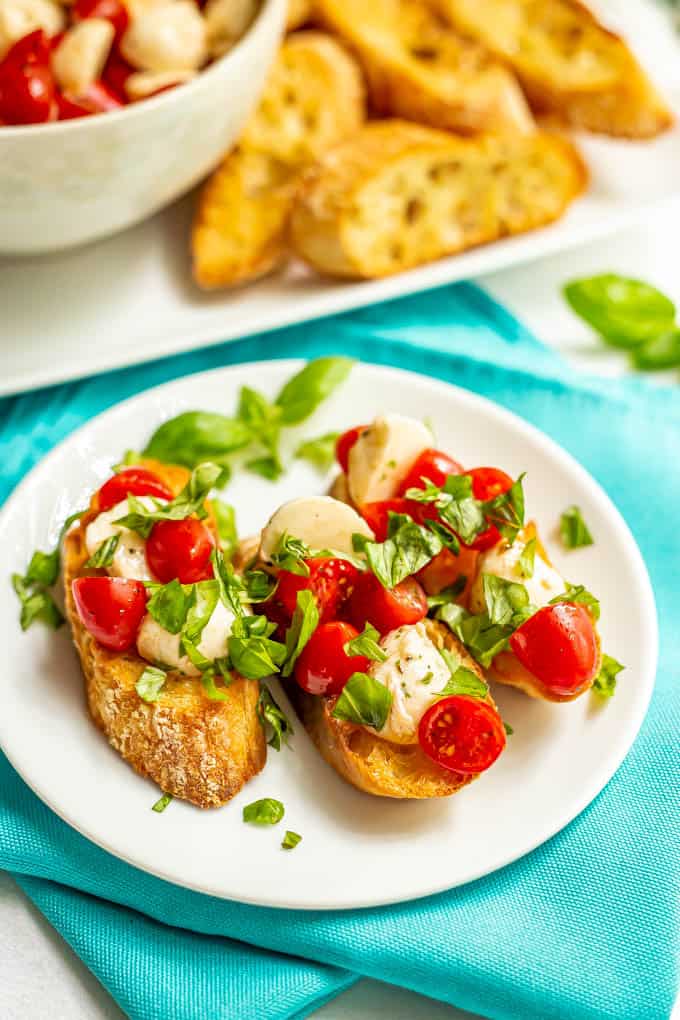 Signora
Palma profusely thanked the crowd, brought out
her girls for a last look then went back and
collapsed on a sofa. “And now,” she said, “we
wait for the orders to come in, then I sleep like a
big bear. Then, I start designing the fall
collection!”
Signora
Palma profusely thanked the crowd, brought out
her girls for a last look then went back and
collapsed on a sofa. “And now,” she said, “we
wait for the orders to come in, then I sleep like a
big bear. Then, I start designing the fall
collection!”
She shoo-ed the models away, telling them
to go have a good time, and reminded Nicola
dinner was at eight-thirty. “We go over
together,” said Signora
Palma. “Is a little trattoria not too well known
by the tourists.”
At eight-thirty—more or less—Signora
Palma, Nicola, and a few of her staff met in the
hotel lobby, had taxis hailed, and drove off to
Trattoria Benedetto, named after the patron
saint of the province. From
the outside it was fairly typical of many
trattorias on Capri—stucco outside and in,
grapevines growing up the exterior walls, a
small dining room with rustic furniture, shelves
holding wine bottles and an antipasti
table crammed with marinated vegetables, local
cheeses and salumi, and bowls of big, bumpy
bright yellow Campanian lemons. The
kitchen was half open, at waist level, and the
owner and his wife did all the ordering, wine
opening, and serving, with the help of their
bored-looking teenage son.
Signora
Palma’s dozen guests took up most of the dining
room, with tables pushed together, and she told
everyone to sit anywhere they’d like. Champagne
was opened and poured and everyone 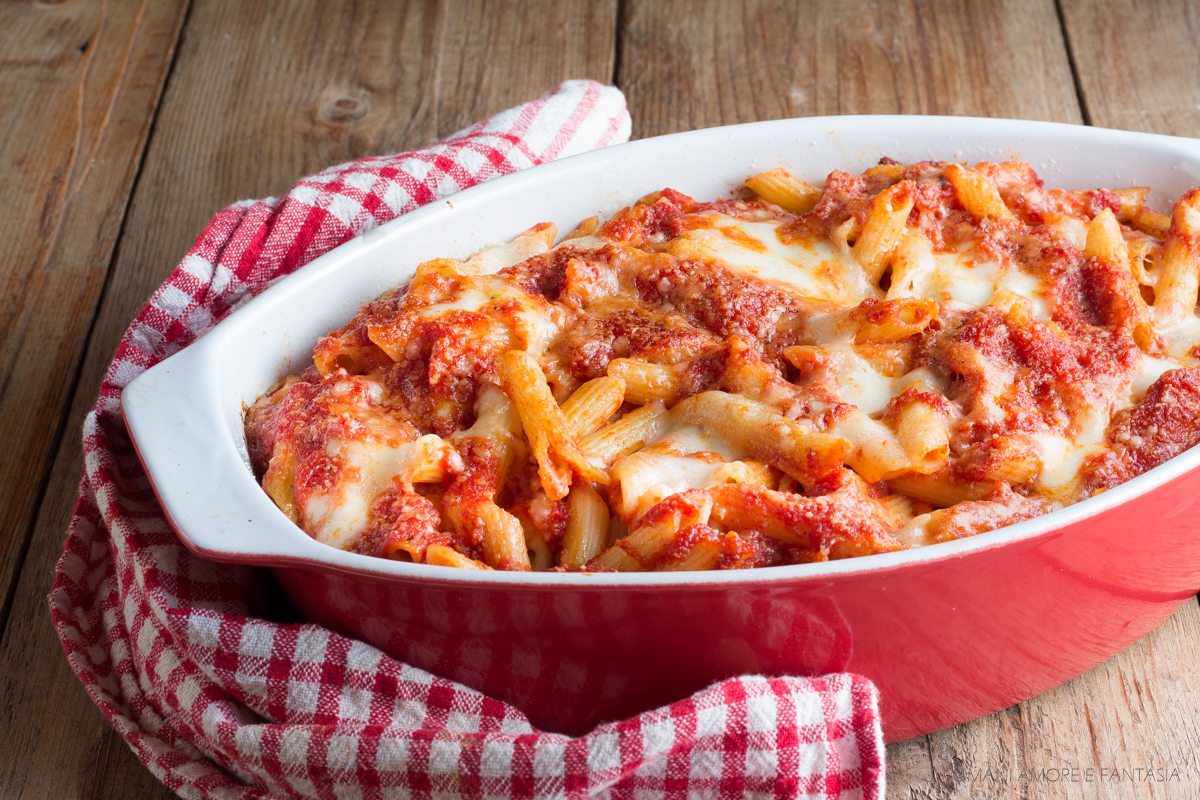 went
to the
antipasti table to help themselves (left). After
the meager meal of the night before and with no
further modeling for the week ahead, Nicola was
good to herself, putting a little of everything
on her plate—the thinly sliced zucchini in olive
oil, caramelized onions, thin fingers of fried
eggplant, warm buffalo mozzarella that had been
made just moments before they arrived, and
various salumi.
went
to the
antipasti table to help themselves (left). After
the meager meal of the night before and with no
further modeling for the week ahead, Nicola was
good to herself, putting a little of everything
on her plate—the thinly sliced zucchini in olive
oil, caramelized onions, thin fingers of fried
eggplant, warm buffalo mozzarella that had been
made just moments before they arrived, and
various salumi.
Back at her seat, Nicola ate with gusto,
finding the food unusually delicious, perhaps
because she was so hungry. But
then, these antipasti—examples
of which she’d had many times both in Italy and
at home—possessed flavors that seemed not just
fresh but elemental. The
flavors burst upon her palate as she sipped her
Champagne.
At that point individual plates of an
appetizer were set before the guests. It was
a rendering of the quintessential Neapolitan
ingredients—tomato, ricotta, basil and olive
oil—yet the chef had taken a small tomato at the
peak of its ripeness, scooped out the insides,
replaced it with housemade ricotta laced with
Parmigiano, set a small piece of basil across
it, then topped it with the cut-off cap of the
tomato. The
confection had then been placed very briefly in
the oven so that everything warmed and the
flavors melded. Then the stuffed tomato was
placed on a bed of arugula and dotted with aged
balsamic vinegar. Everyone at the table
expressed their pleasure by variations on a
swoon, saying the dish was fantastico!
superba!
grande!
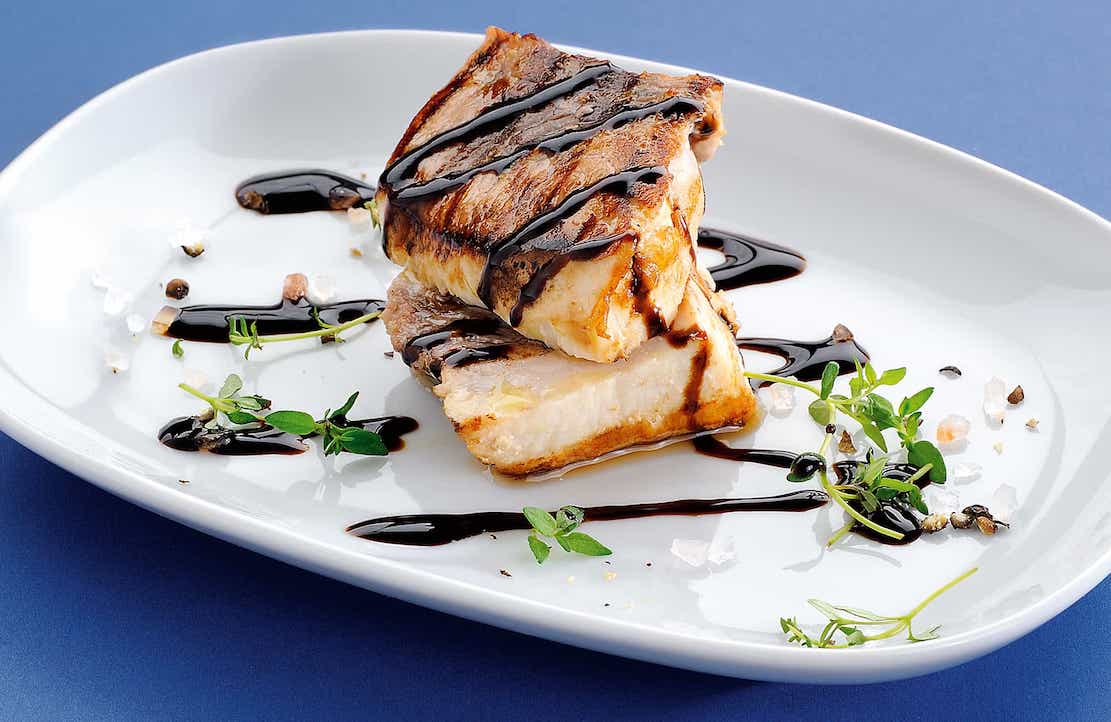 Next came the chef’s take on ziti alla
sorrentina (above), which meant it
would have a tomato and eggplant sauce. But
again, when Nicola tasted the result, it was as
if she’d never had the dish before, or at least
not with this refinement. The
spaghetti itself, made in the kitchen, was
tender and its strands entwined in a kind of
hive, each coated with a sauce whose sweetness
was pure and natural, the eggplant just soft
enough to add a creamy element to the dish,
which was lightly sprinkled with local pecorino.
Next came the chef’s take on ziti alla
sorrentina (above), which meant it
would have a tomato and eggplant sauce. But
again, when Nicola tasted the result, it was as
if she’d never had the dish before, or at least
not with this refinement. The
spaghetti itself, made in the kitchen, was
tender and its strands entwined in a kind of
hive, each coated with a sauce whose sweetness
was pure and natural, the eggplant just soft
enough to add a creamy element to the dish,
which was lightly sprinkled with local pecorino.
When that dish was
cleared, a glorious risotto was served, cooked
in tomato water, not sauce, so that it had a
tang to it that Nicola almost thought was lemon. The
seasonings were subtle, absorbed into the fat
rice kernels through careful, long stirring.
The main course was kept very simple:
each guest received a cut of barely cooked
swordfish—pesce spada (left)—on top of
which were quickly caramelized onions that had
softened then acquired a little crispness for
texture. Minced
basil looking like confetti adorned the fish,
which was given a benediction of olive oil in
which a clove of garlic had been crushed. With
the food, the guests had switched to a wine
called Taurasi from the region.
The
guests were raving about the food and Signora
Palma could not have been happier. “You see,”
she said, “I told
you the chef was un genio.
And he is also very handsome.” Turning
to the owner, she asked—well, more or less
demanded—to have the chef brought out.
A few minutes later he appeared, having
changed into a clean white chef’s jacket with
the trattoria’s name on it. The
guests applauded and Signora
Palma introduced the chef. “Signore e
signori, mi presente il maestro—Marco di
Noè!” More applause, then the young chef, who
was indeed very handsome, with blue-gray eyes
and thick hair as dark as Nicola’s. He
humbly thanked everyone, saying that it was an
honor to cook for Signora Palma,
who
demanded he sit down at her table, moving a
chair in next to Nicola.
Nicola congratulated him on a meal that
seemed so simple yet so remarkably different,
asking how he did it. The young chef shrugged,
ran his fingers through his dark hair and said “Senza
l’ultimo ingredienti, c’e niente.” Without
the best ingredients it is nothing.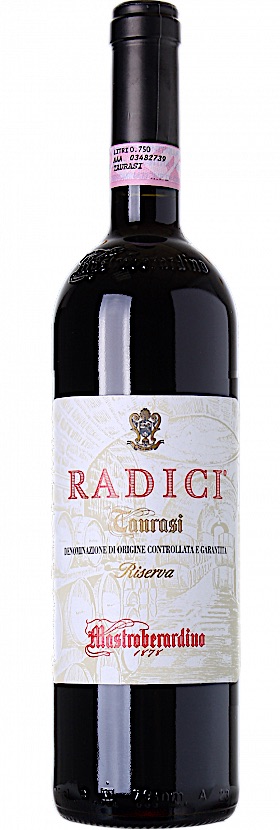
Then, sensing Nicola was not Italian
asked, “You are American, yes?”
“I’m Italian-American,” she replied. “I was
born and raised in New York.”
“But your parents were Neapolitan, no? I
hear it in your accent.”
Nicola remembered the last time she had a
meal at which this topic had proven a harbinger
of disappointment.
She told Marco her father’s side of the
family was from Abruzzo, though his mother was
from Emilia-Romagna, and her mother’s side was
strictly Neapolitan, which is how Nicola had
picked up the accent.
“Plus,” she said, “most of the people in
my neighborhood in the Bronx came from Campania,
so I hear it a lot.”
“I speak the true dialect a lot around
here—I was born in Naples—though on Capri I
speak more Italian, French, Spanish, German.”
“You speak all those languages?”
“Yes, I find it easy to pick them up. Spanish
and
French are very easy for an Italian.”
Marco accepted Signora
Palma’s invitation to have a glass of Taurasi. He
thanked her for it and said, “This is the best
producer of this wine—Mastroberardino, in
Atripalda.
The family has brought back a lot of the
grape varieties that were thought to be lost.”
Nicola truly was amazed by Marco’s
fluency in English, which sounded as though he’d
learned from British teachers. The two young
people kept talking together, getting the usual
details on their backgrounds, and Marco seemed
delighted that Nicola had Neapolitan blood
running through her veins.
“So, you are a model?” he asked, not
hinting if he was impressed by or disdainful of
the profession.
“I do a little modeling, yes, but I came
to Italy last spring as part of a semester
abroad in Milan.”
“Where do you go to school?”
“Columbia University in New York.”
“Ah, I understand it is a very good
school. And
what do you study?”
“Art history, specifically the art of the
Italian Renaissance,” she said, feeling quite at
ease. “I
hope to go on for my PhD next fall.”
“Really? And how do you find the time to
model?”
“Whenever I have time, I try to take a
job.”
Marco nodded, as if to say, this seems
like a smart American girl. “Who,
may I ask, are some of your favorite Renaissance
artists?”
“Well,” said Nicola, never having been
quizzed on the subject by a cook, “the usual
great ones, da Vinci, Raphael, Donatello, but I
find I’m particularly drawn to the Venetian
artists.”
Marco continued nodding, this time
somewhat wearily. “Bellini, Carpaccio, Titian,
Tintoretto, Veronese,” he said, “and the rest.”
“Absolutely! You know the subject well.”
“But, about these Venetians. What
do you like about them?”
“Well, their coloring, the high drama,
the psychology they show in their portraits.”
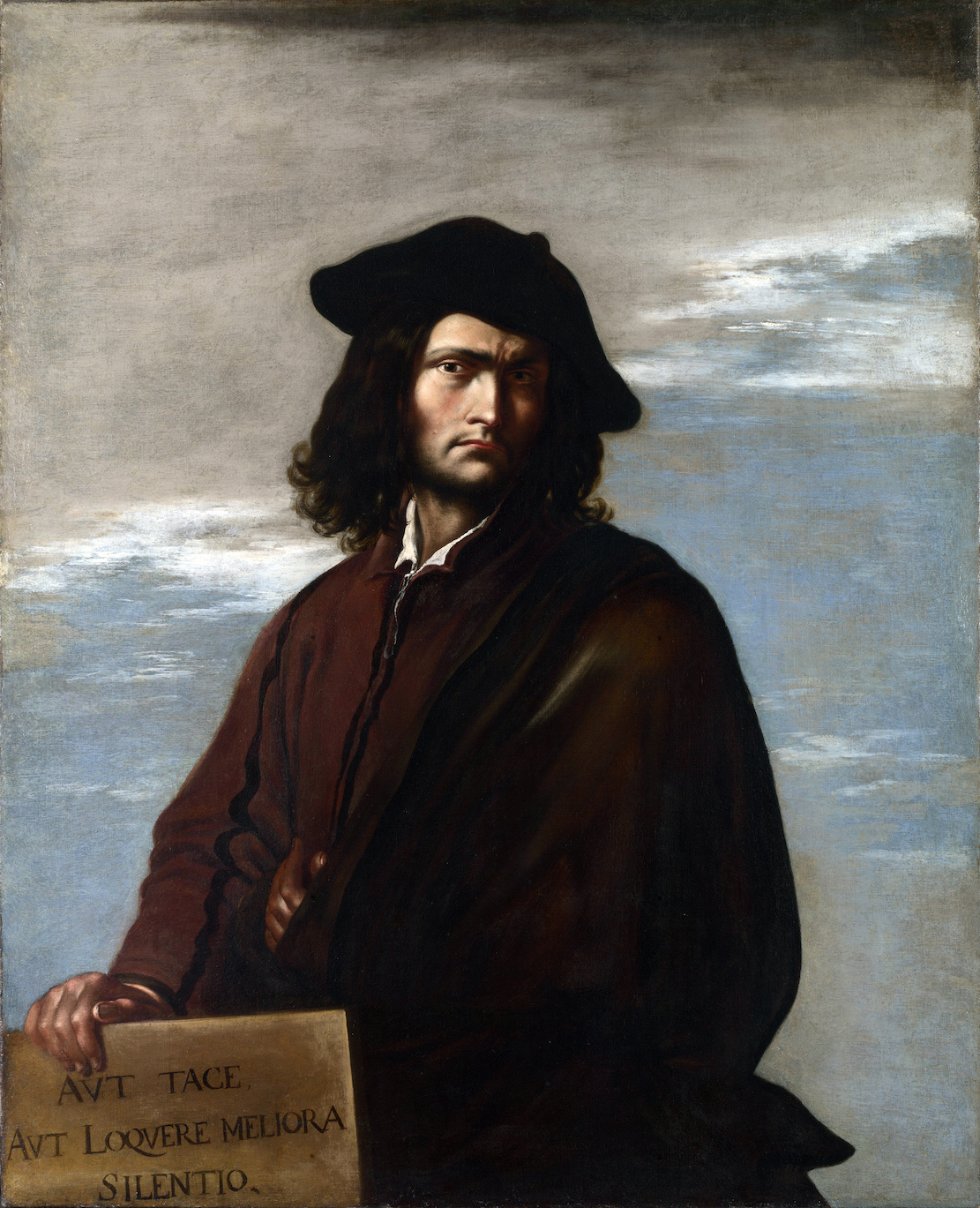 Marco put up his
hands and said, “You know what Michelangelo said
about the Venetians?”
Marco put up his
hands and said, “You know what Michelangelo said
about the Venetians?”
“No, what?”
“He said they’d be much better artists if
they’d learn how to draw.”
Nicola was shocked. “Michelangelo said
that?”
Marco then launched into a well-informed
discussion of why he thought the Venetians were
inferior to the other schools of the
Renaissance, contending that it was the
Neapolitan baroque artists who had been
underrated and underappreciated.
“Like who?” asked Nicola, riffling
through her brain to think of any famous
Neapolitan artists.
“Ah, so many: Caracciolo, Rosa,
Cavallino, Sellitto, Stanzione, so many you have
probably never heard of.”
Indeed, Nicola had not, even though the
Neapolitan School was an important part of the
Italian Baroque, and she wondered at how much
Chef Marco di Noè seemed to know about it. She
was also intrigued by Marco’s being the first
man in Italy who id not immediately comment on
how beautiful she was.
“How do you know so much about these
artists?” she asked.
“Because I am not just a chef, Signorina,
I am also a painter. Not a
very good painter, but I work as a chef for the
season on Capri, then work on my painting the
rest of the time.”
“So you have a studio here on the island?
I’d love to see some of your work.”
“No, I live in Naples when I’m not here. Perhaps
you would like to visit the Museo di Capodimonte
to see the Neapolitan School, and if you have
time, some of my work. I have
some hanging in galleries in the city.”
Salvator
Rosa, "Self-Portrait."
Nicola
would
have loved at least to see the museum but told
Marco, “That would be wonderful but I have to
leave on Tuesday.”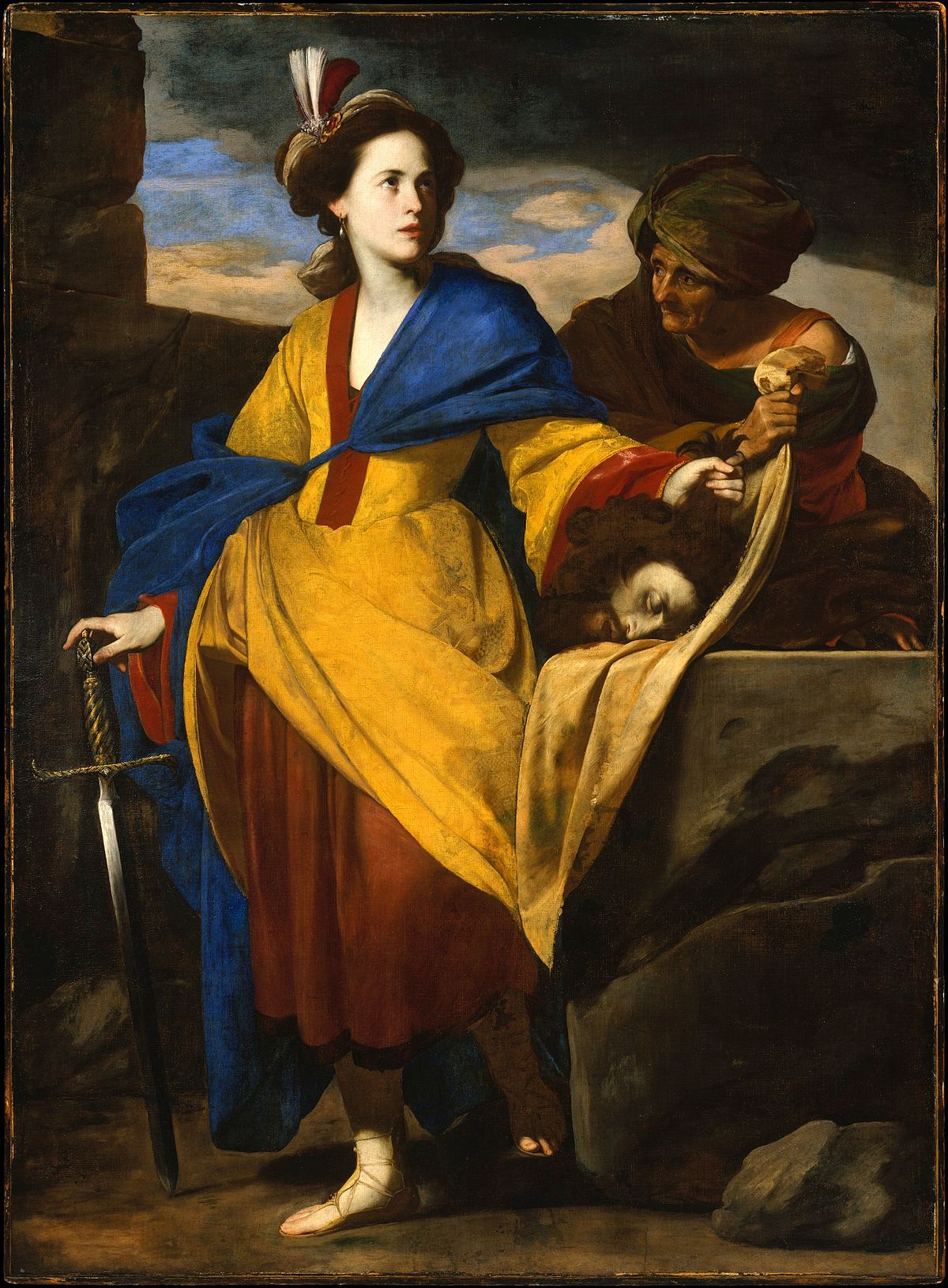
“So,” he countered, “tomorrow is Sunday.
I can take the day off—I’ve been working seven
days a week since April and now the season is
almost over and there’s not much business. We
can take the fast ferry over, I’ll show you the
city, and we can be back in Capri in the
evening.”
Nicola gave the matter about five
seconds’ thought and said, “Marco, let’s do it. What
time?”
“Signorina
Santini—“
“Please call me Nicola.”
“Ah, prego,
Nicola. Okay, we get an early ferry out tomorrow
morning and will be in Napoli by the time the
museum opens.”
They settled on a time, and Marco said
he’d pick her up at her hotel, then taxi down to
the dock. Meanwhile
Signora
Palma’s guests were getting up and thanking both
their host and the trattoria’s owners.
“A
domani, Nicola,” said Marco.
“A
domani,” and with that Marco shook
Nicola’s hand and said goodnight.
When
Nicola
got back to her room, she turned the evening
over in her mind, trying to figure out this
chef-painter with the deferential manners. He was
obviously a superb cook and knew much more about
Neapolitan art than she did, and he seemed to be
a good enough artist to be in galleries. And he
was very handsome, to boot. A very
nice piece of work, Marco was. And
with just two days left in Italy, she was
determined to make the most of it.
Massimo Stanzione, "Judith
and Holofernes."
LIFTING HOLIDAY SPIRITS
By John Mariani
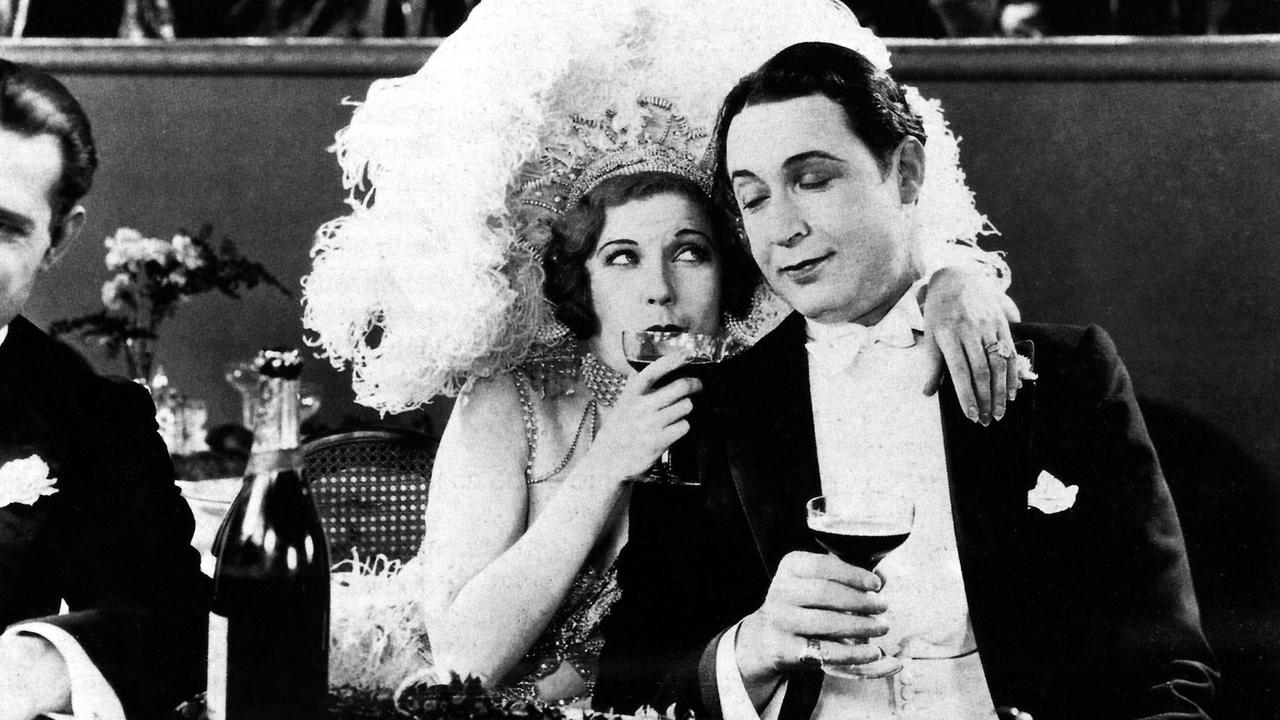
Most people, I suspect, are very true to their spirits brands, both out of familiarity and because the options have grown so large that finding yet another single malt Scotch aged in bourbon casks or vodka filtered through moon rocks rarely makes for a new preference. It is, however, fun to be a bit adventurous around the holidays, especially when including those you might want to taste something new and interesting or even something they might never have thought of drinking. Here are some new and old suggestions I’ve been enjoying.
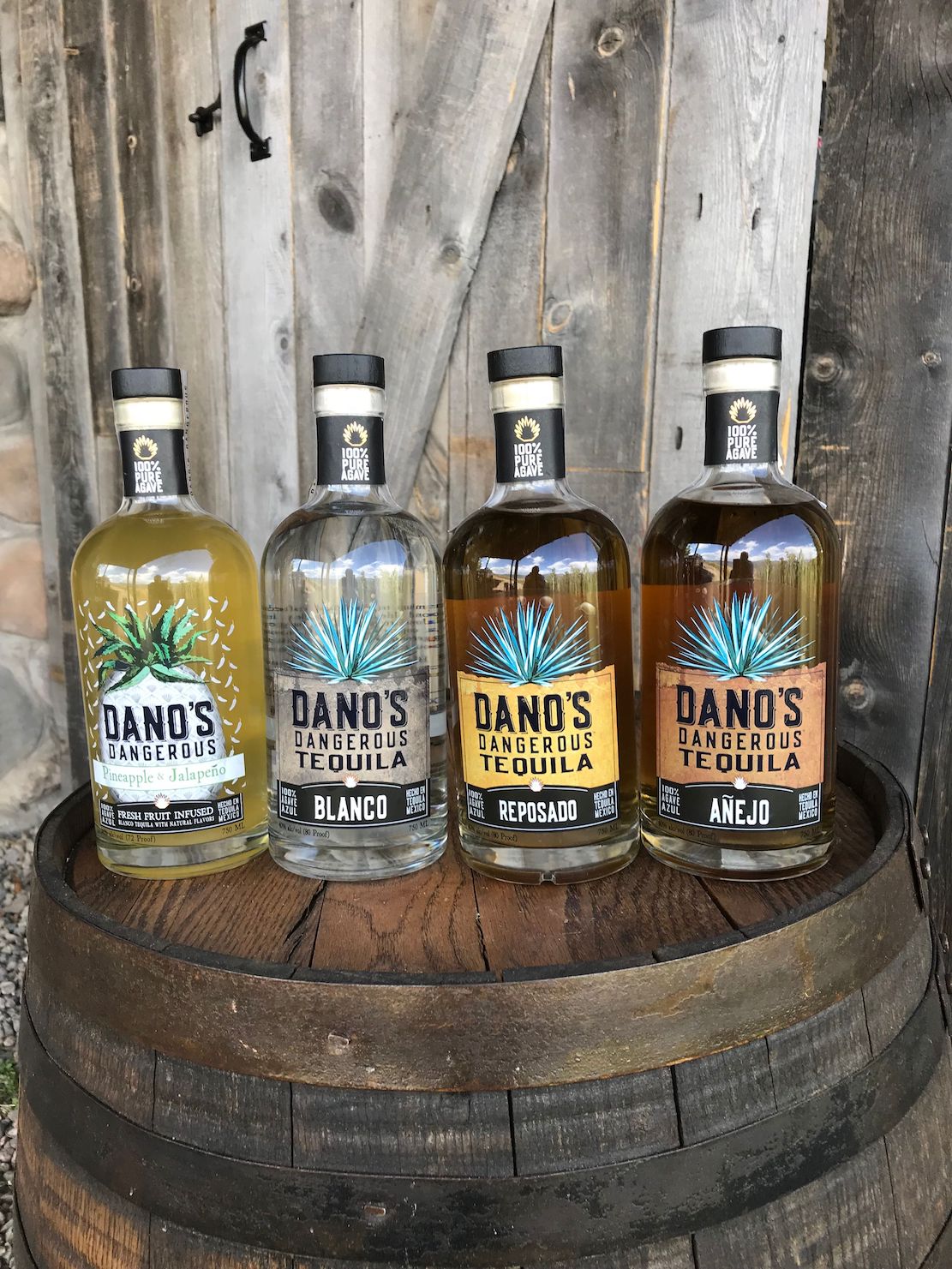 DANO’S
TEQUILA
DANO’S
TEQUILAThe market is now overflowing with “sipping tequilas,” usually limited release añejos, but I, for one, cannot imagine myself nursing one before a roaring fire. I do, though, like the variations that make margaritas take on nuance beyond the basic blancos. The family-owned Dano’s, founded not in Mexico but in Steamboat Springs, Colorado, in 2018, shows that you can get good results using 100% agave when you depend on a distillery in Mexico dating back to 1841. I’m not a fan of flavored tequilas, like Dano’s pineapple and jalapeño, but its reposado ($53), aged for nine months in white oak barrels, is a soft tequila with complexity, and, yes, it’s perfect for a margarita.
FOS GREEK MASTIHA LIQUEUR
Greece may be well known for its resinous wines and liqueurs like licorice-tasting ouzo, but mastiha is something unusual and quite delicious. It, too, is made from a resin from the mastiha tree (known as the “crying tree”), grown only on the small Mediterranean island of Chios. Used as a flavoring in baked goods, it has only a touch of anise, as well as pine and various herbs, and it is sweet without being cloying, very good on the rocks, though it would make a nice mixer with brandy. As far as I know Fos’s bottling ($40) is the only one exported to the U.S.
STRANAHAN’S BLUE PEAK SINGLE MALT WHISKEY
It can’t be called Scotch by law, but this Colorado-based single malt, with a solera finish, comes in at 43% alcohol and has a very pleasing balance of heat and sweet undertones. I’m not sure if it makes any difference that the whiskey is “handcrafted at high altitude” or “cut to proof with pristine Rocky Mountain water,” but I like its bite and its true malt taste, without much peatiness ($50). They make six variations,
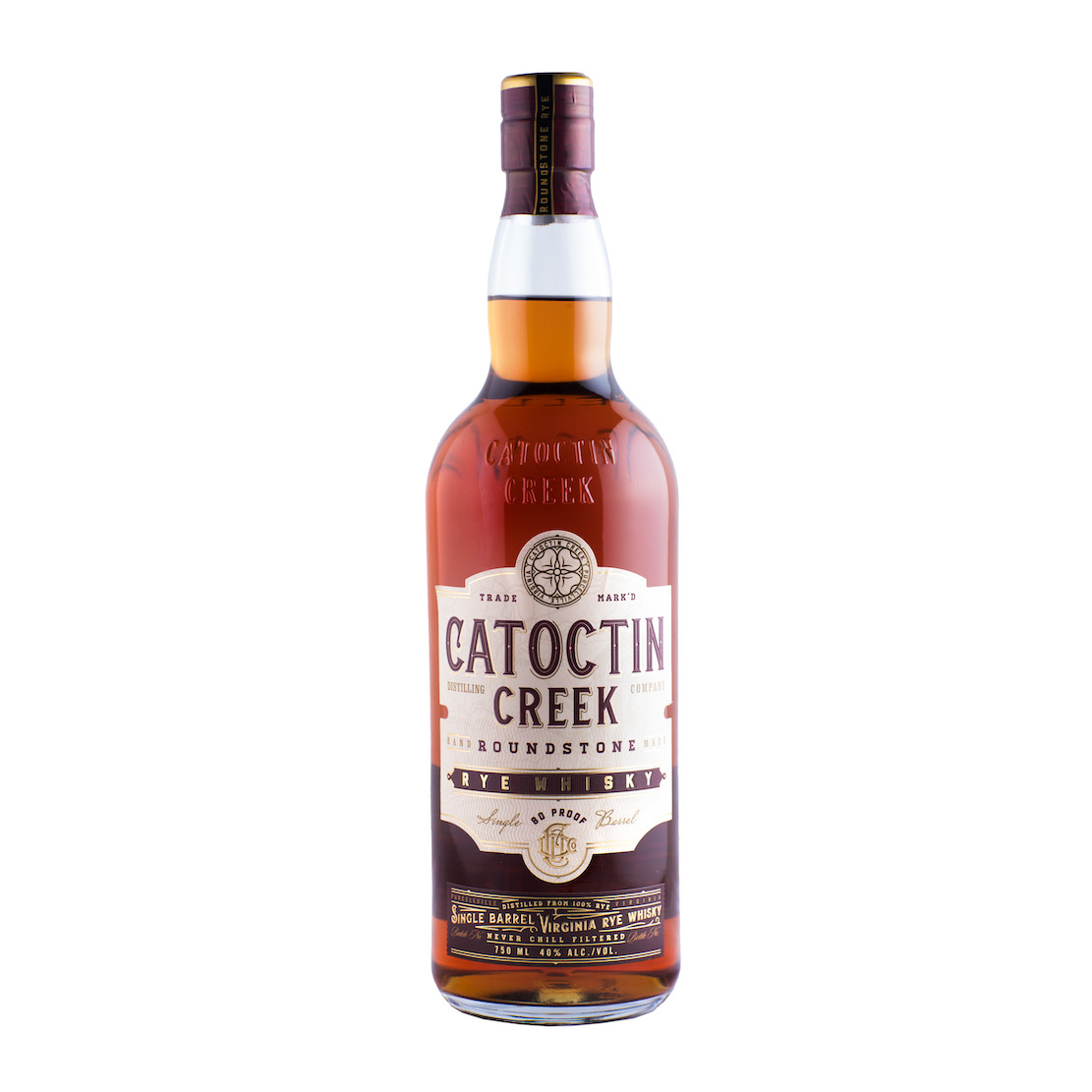 some
with higher proof; one, with the way-too-cute
name Snowflake, is only made on one day in
December each year.
some
with higher proof; one, with the way-too-cute
name Snowflake, is only made on one day in
December each year. CATOCTIN CREEK
Founded by Becky and
Scott Harris in 2009 as the first legal
distillery in Loudoun County, Virginia, since
before Prohibition, Catoctin Creek revels in
making rye, a spirit not too many years ago
relegated to the shelves near the cash
registers in liquor stores. Catoctin’s
ryes—the Indian name meant "place of many
deer"—are made in several styles, including
Roundstone ($45), made from 100% rye at 89
proof, Distiller’s Edition at 92 proof ($53),
“pulled from the back of the barn,” and the
powerhouse top-of-the-line Cask Proof ($90) at
116 proof.
I tasted and thoroughly
enjoyed the Catoctin Creek Peach Barrel
Select
80 Proof ($46).They also
make gins, brandies, fruit
brandies—even a Wolfgang Puck Rye
finished in California Zinfandel
barrels from Ravenswood. Too many,
really, when the label should stick
with its best iterations of rye it
does so impressively.
CLÉMENT CUVÉE HOMÈRE
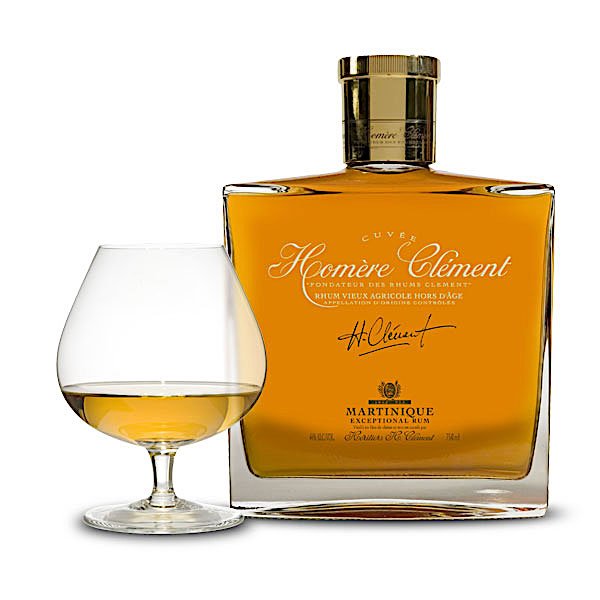 Clément is known for its flavored
Martinique rums, like shrub, but it makes some
superior and very distinctive rums like this
cuvée from the Cellar Master’s Selection Series
culled from the highest-rated vintage rums of
the last fifteen years ($110). It is aged in
French Limousin barriques and re-charred Bourbon
barrels. It is woody, has a long finish and is
quite a bit drier than most other Caribbean
rums. And, as a gift, it comes in a beautiful
squat bottle. The name commemorates Homère
Clément, the planter who founded the distillery,
which mimicked the spirits techniques of
Armagnac, which he called Rhum Agricole.
Clément is known for its flavored
Martinique rums, like shrub, but it makes some
superior and very distinctive rums like this
cuvée from the Cellar Master’s Selection Series
culled from the highest-rated vintage rums of
the last fifteen years ($110). It is aged in
French Limousin barriques and re-charred Bourbon
barrels. It is woody, has a long finish and is
quite a bit drier than most other Caribbean
rums. And, as a gift, it comes in a beautiful
squat bottle. The name commemorates Homère
Clément, the planter who founded the distillery,
which mimicked the spirits techniques of
Armagnac, which he called Rhum Agricole. NOILLY PRAT VERMOUTH ROUGE
Why bother mentioning a red vermouth that hasn’t changed since 1813? Simply because whenever I get nostalgic for the first cocktails I ever drank five decades ago, more often than not there was red vermouth in them. I was never a Martini guy, so white vermouth held little interest for me, but I loved the red vermouth as part of the Negroni, Manhattan, Americano and Bronx cocktails. And because it was delicious all on its own, with a twist of lemon or orange, I’ve found it makes a light, herbaceous aperitif, with 29 herbs, all on its own ($12.50). There have been some feeble attempts to make new vermouths in the market, but Noilly Prat perfected theirs a long, long time ago.
 AH,
THANK GOD! NOW THE WORLD CAN
AH,
THANK GOD! NOW THE WORLD CAN
SPIN ON ITS AXIS AGAIN!
It
has been widely reported on the internet that TV
chef and author Nigella Lawson has admitted she
does not know how to pronounce "microwave." Before
adding milk to boiled potatoes, she said, “A
bit of milk, full fat, which I’ve warmed in
the mee-kro-whaav-é.” Then reproached
herself saying, "Is
that how it’s supposed to be pronounced? Have I
been wrong all this time?"
BREAKING NEWS! CHAMOY AND
DUKKAH 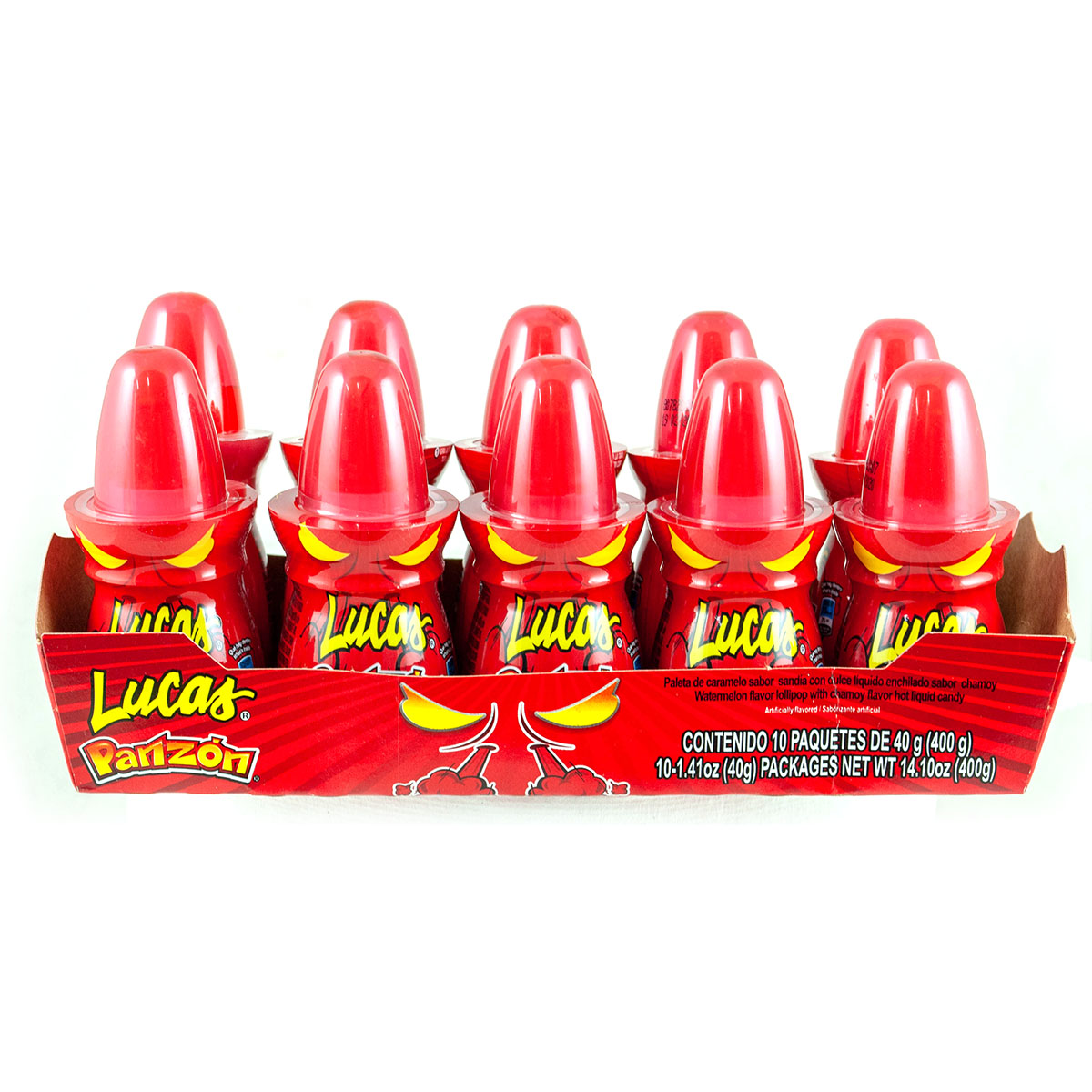
SUPPLIES RUNNING LOW IN AMERICA!
4 Global Flavors
That Defined the Past 20 Years, according to the
McCormick Flavor Forecast:
Pumpkin Pie Spice
Turmeric
Chamoy
Dukkah
Sponsored by

Any of John Mariani's books below may be ordered from amazon.com.
 The Hound in Heaven
(21st Century Lion Books) is a novella, and
for anyone who loves dogs, Christmas, romance,
inspiration, even the supernatural, I hope you'll find
this to be a treasured favorite. The story
concerns how, after a New England teacher, his wife and
their two daughters adopt a stray puppy found in their
barn in northern Maine, their lives seem full of promise.
But when tragedy strikes, their wonderful dog Lazarus and
the spirit of Christmas are the only things that may bring
his master back from the edge of despair.
The Hound in Heaven
(21st Century Lion Books) is a novella, and
for anyone who loves dogs, Christmas, romance,
inspiration, even the supernatural, I hope you'll find
this to be a treasured favorite. The story
concerns how, after a New England teacher, his wife and
their two daughters adopt a stray puppy found in their
barn in northern Maine, their lives seem full of promise.
But when tragedy strikes, their wonderful dog Lazarus and
the spirit of Christmas are the only things that may bring
his master back from the edge of despair. WATCH THE VIDEO!
“What a huge surprise turn this story took! I was completely stunned! I truly enjoyed this book and its message.” – Actress Ali MacGraw
“He had me at Page One. The amount of heart, human insight, soul searching, and deft literary strength that John Mariani pours into this airtight novella is vertigo-inducing. Perhaps ‘wow’ would be the best comment.” – James Dalessandro, author of Bohemian Heart and 1906.
“John Mariani’s Hound in Heaven starts with a well-painted portrayal of an American family, along with the requisite dog. A surprise event flips the action of the novel and captures us for a voyage leading to a hopeful and heart-warming message. A page turning, one sitting read, it’s the perfect antidote for the winter and promotion of holiday celebration.” – Ann Pearlman, author of The Christmas Cookie Club and A Gift for my Sister.
“John Mariani’s concise, achingly beautiful novella pulls a literary rabbit out of a hat – a mash-up of the cosmic and the intimate, the tragic and the heart-warming – a Christmas tale for all ages, and all faiths. Read it to your children, read it to yourself… but read it. Early and often. Highly recommended.” – Jay Bonansinga, New York Times bestselling author of Pinkerton’s War, The Sinking of The Eastland, and The Walking Dead: The Road To Woodbury.
“Amazing things happen when you open your heart to an animal. The Hound in Heaven delivers a powerful story of healing that is forged in the spiritual relationship between a man and his best friend. The book brings a message of hope that can enrich our images of family, love, and loss.” – Dr. Barbara Royal, author of The Royal Treatment.
 |
The Encyclopedia of American Food and Drink by John F. Mariani (Bloomsbury USA, $35) Modesty forbids me to praise my own new book, but let me proudly say that it is an extensive revision of the 4th edition that appeared more than a decade ago, before locavores, molecular cuisine, modernist cuisine, the Food Network and so much more, now included. Word origins have been completely updated, as have per capita consumption and production stats. Most important, for the first time since publication in the 1980s, the book includes more than 100 biographies of Americans who have changed the way we cook, eat and drink -- from Fannie Farmer and Julia Child to Robert Mondavi and Thomas Keller. "This book is amazing! It has entries for everything from `abalone' to `zwieback,' plus more than 500 recipes for classic American dishes and drinks."--Devra First, The Boston Globe. "Much needed in any kitchen library."--Bon Appetit. |
"Eating Italian will never be the same after reading John Mariani's entertaining and savory gastronomical history of the cuisine of Italy and how it won over appetites worldwide. . . . This book is such a tasteful narrative that it will literally make you hungry for Italian food and arouse your appetite for gastronomical history."--Don Oldenburg, USA Today. "Italian
restaurants--some good, some glitzy--far
outnumber their French rivals. Many of
these establishments are zestfully described
in How Italian Food Conquered the World, an
entertaining and fact-filled chronicle by
food-and-wine correspondent John F.
Mariani."--Aram Bakshian Jr., Wall Street
Journal.
"Equal parts
history, sociology, gastronomy, and just
plain fun, How Italian Food Conquered the
World tells the captivating and delicious
story of the (let's face it) everybody's
favorite cuisine with clarity, verve and
more than one surprise."--Colman Andrews,
editorial director of The Daily
Meal.com. "A fantastic and fascinating
read, covering everything from the influence
of Venice's spice trade to the impact of
Italian immigrants in America and the
evolution of alta cucina. This book will
serve as a terrific resource to anyone
interested in the real story of Italian
food."--Mary Ann Esposito, host of PBS-TV's
Ciao
Italia. "John Mariani has written the
definitive history of how Italians won their
way into our hearts, minds, and
stomachs. It's a story of pleasure over
pomp and taste over technique."--Danny Meyer,
owner of NYC restaurants Union Square
Cafe, The Modern, and Maialino.
|
 |
 |
 |
 |
 |
 |
 |
 |
 Everett Potter's Travel Report:
Everett Potter's Travel Report: 
 Eating Las Vegas JOHN
CURTAS has been covering the Las Vegas food and
restaurant scene since 1995. He is the co-author
of EATING LAS
VEGAS – The 50 Essential Restaurants (as
well as the author of the Eating Las Vegas
web site: www.eatinglasvegas.
He can also be seen every Friday morning as the
“resident foodie” for Wake Up With the Wagners
on KSNV TV (NBC) Channel 3 in Las Vegas.
Eating Las Vegas JOHN
CURTAS has been covering the Las Vegas food and
restaurant scene since 1995. He is the co-author
of EATING LAS
VEGAS – The 50 Essential Restaurants (as
well as the author of the Eating Las Vegas
web site: www.eatinglasvegas.
He can also be seen every Friday morning as the
“resident foodie” for Wake Up With the Wagners
on KSNV TV (NBC) Channel 3 in Las Vegas.
MARIANI'S VIRTUAL GOURMET
NEWSLETTER is published weekly. Publisher: John Mariani. Editor: Walter Bagley. Contributing Writers: Christopher Mariani,
Robert Mariani, Misha Mariani, John A. Curtas, Gerry Dawes, Geoff Kalish,
and Brian Freedman. Contributing
Photographer: Galina Dargery. Technical
Advisor: Gerry
McLoughlin.
If you wish to subscribe to this
newsletter, please click here: http://www.johnmariani.com/subscribe/index.html
© copyright John Mariani 2021

